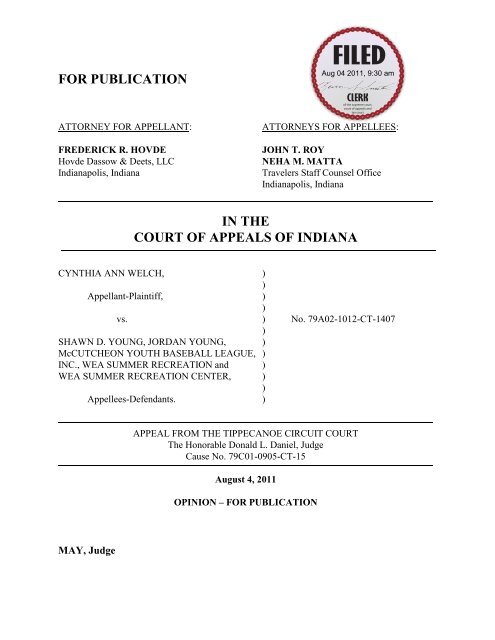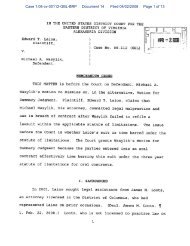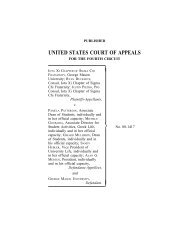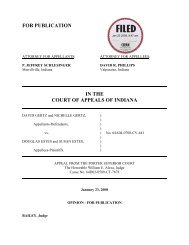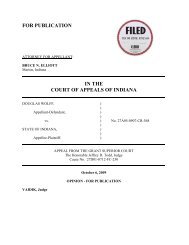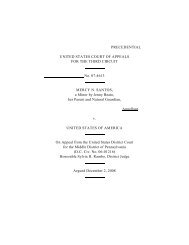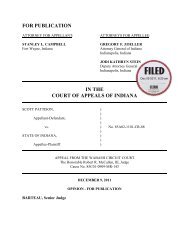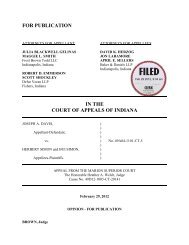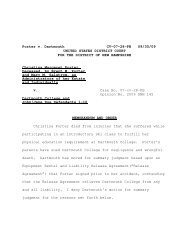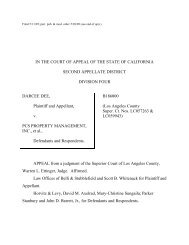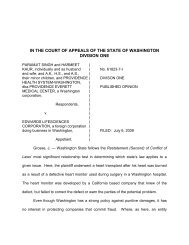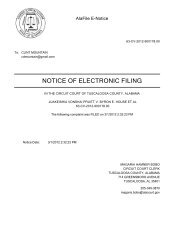Cynthia Ann Welch v. Shawn D. Young, et al. - State of Indiana
Cynthia Ann Welch v. Shawn D. Young, et al. - State of Indiana
Cynthia Ann Welch v. Shawn D. Young, et al. - State of Indiana
You also want an ePaper? Increase the reach of your titles
YUMPU automatically turns print PDFs into web optimized ePapers that Google loves.
FOR PUBLICATION<br />
ATTORNEY FOR APPELLANT: ATTORNEYS FOR APPELLEES:<br />
FREDERICK R. HOVDE JOHN T. ROY<br />
Hovde Dassow & De<strong>et</strong>s, LLC NEHA M. MATTA<br />
<strong>Indiana</strong>polis, <strong>Indiana</strong> Travelers Staff Counsel Office<br />
<strong>Indiana</strong>polis, <strong>Indiana</strong><br />
IN THE<br />
COURT OF APPEALS OF INDIANA<br />
CYNTHIA ANN WELCH, )<br />
)<br />
Appellant-Plaintiff, )<br />
)<br />
vs. ) No. 79A02-1012-CT-1407<br />
)<br />
SHAWN D. YOUNG, JORDAN YOUNG, )<br />
McCUTCHEON YOUTH BASEBALL LEAGUE, )<br />
INC., WEA SUMMER RECREATION and )<br />
WEA SUMMER RECREATION CENTER, )<br />
)<br />
Appellees-Defendants. )<br />
MAY, Judge<br />
APPEAL FROM THE TIPPECANOE CIRCUIT COURT<br />
The Honorable Don<strong>al</strong>d L. Daniel, Judge<br />
Cause No. 79C01-0905-CT-15<br />
August 4, 2011<br />
OPINION – FOR PUBLICATION
<strong>Cynthia</strong> <strong>Welch</strong> was injured when a little league player who was taking practice swings<br />
struck her knee with a bat. She sued the player, Jordan <strong>Young</strong>; the player‟s father and coach,<br />
<strong>Shawn</strong> <strong>Young</strong>; McCutcheon Youth Baseb<strong>al</strong>l League, Inc.; and Wea Township through Wea<br />
Summer Recreation and Wea Summer Recreation Center (“Wea defendants”). 1 The Wea<br />
defendants and <strong>Shawn</strong> <strong>Young</strong> moved for summary judgment, which the court granted. 2<br />
<strong>Welch</strong> moved to correct error and her motion was denied.<br />
Our <strong>Indiana</strong> Supreme Court has articulated a new rule for d<strong>et</strong>ermining liability in<br />
cases like the one before us, and there are questions <strong>of</strong> fact as to where Jordan <strong>Young</strong> was<br />
when he was taking the practice swings and wh<strong>et</strong>her the game had started when <strong>Welch</strong> was<br />
injured. Thus, summary judgment was inappropriate under the new standard 3 and we<br />
accordingly affirm in part, reverse in part, and remand. 4<br />
1 The Wea defendants own and operate the baseb<strong>al</strong>l field.<br />
2 The summary judgment motion does not list Jordan <strong>Young</strong> or McCutcheon Youth Baseb<strong>al</strong>l League, Inc. as<br />
movants. The chronologic<strong>al</strong> case summary indicates both were served as defendants, and no subsequent entry<br />
indicates either defendant was dismissed. Nor does the tri<strong>al</strong> court address in its summary judgment orders the<br />
leg<strong>al</strong> status <strong>of</strong> either defendant, except to note neither was named as a moving party on summary judgment.<br />
Accordingly, we address only those parties that moved for and were granted summary judgment: <strong>Shawn</strong> <strong>Young</strong><br />
and the Wea defendants.<br />
As to <strong>Shawn</strong> <strong>Young</strong> and the Wea defendants, we note neither party has explicitly addressed on appe<strong>al</strong><br />
the basis for their potenti<strong>al</strong> tort liability. Both parties‟ arguments on appe<strong>al</strong> focused on the actions <strong>of</strong> <strong>Welch</strong><br />
and Jordan <strong>Young</strong>. <strong>Welch</strong>‟s complaint <strong>al</strong>leges <strong>Shawn</strong> <strong>Young</strong> was “negligent in the supervision <strong>of</strong> Jordan,”<br />
(App. at 119), and was an agent <strong>of</strong> Wea, but <strong>Welch</strong> does not explicitly address negligent supervision or agency<br />
in her appellate briefs.<br />
3 As explained below, while summary judgment for <strong>Shawn</strong> <strong>Young</strong> was inappropriate under our Supreme<br />
Court‟s new standard to the extent he might be subject to liability based on his relationship to the little league,<br />
this summary judgment was not error to the extent he was immune from suit as a Wea Township employee.<br />
4 We heard or<strong>al</strong> argument June 23, 2011, at <strong>Indiana</strong> <strong>State</strong> University in Terre Haute before an audience <strong>of</strong><br />
2
FACTS AND PROCEDURAL HISTORY<br />
The facts most favorable to <strong>Welch</strong>, the non-moving party, are that <strong>Welch</strong>‟s son played<br />
in the Wea Summer Recreation little league for a team coached by <strong>Shawn</strong> <strong>Young</strong>. Jordan<br />
<strong>Young</strong>, <strong>Shawn</strong>‟s eleven-year-old son, was on the same team as <strong>Welch</strong>‟s son. <strong>Welch</strong><br />
described herself as the “team Mom.” 5 (App. at 101.)<br />
On May 30, 2007, <strong>Welch</strong> dropped <strong>of</strong>f her son at the baseb<strong>al</strong>l field, then went to a<br />
drugstore to buy gum for the team. She r<strong>et</strong>urned and began passing out gum to the players.<br />
Jordan <strong>Young</strong> was warming up with practice swings outside the dugout, when his bat hit<br />
<strong>Welch</strong> in the knee.<br />
<strong>Welch</strong> filed a complaint <strong>al</strong>leging various theories <strong>of</strong> liability. <strong>Shawn</strong> <strong>Young</strong> and the<br />
Wea defendants moved for summary judgment. In an order dated August 10, 2010, the tri<strong>al</strong><br />
court granted summary judgment for <strong>al</strong>l the defendants for various reasons. It noted <strong>Welch</strong><br />
admitted (1) an action against the coach, <strong>Shawn</strong> <strong>Young</strong>, was barred by Ind. Code § 34-13-3-<br />
5(b) because his employer, Wea Township, is a government<strong>al</strong> entity; and (2) defendants Wea<br />
Summer Recreation and Wea Summer Recreation Center were not liable for Jordan <strong>Young</strong>‟s<br />
Hoosier Girls <strong>State</strong> participants. We thank the University and Hoosier Girls <strong>State</strong> for their hospit<strong>al</strong>ity and<br />
commend counsel on the qu<strong>al</strong>ity <strong>of</strong> their advocacy.<br />
5<br />
<strong>Welch</strong>‟s affidavit indicated her duty as “team mom” was to find parents to work the concession stand. She<br />
“had no responsibilities in connection with any practices or games.” (App. at 74.)<br />
3
negligence. The court <strong>al</strong>so noted <strong>Welch</strong> had made no argument <strong>Shawn</strong> <strong>Young</strong> was liable in<br />
an individu<strong>al</strong> capacity.<br />
<strong>Welch</strong> moved to correct error, arguing she had not conceded the Wea defendants were<br />
not liable as a government<strong>al</strong> entity or through their employee <strong>Shawn</strong> <strong>Young</strong>, and further<br />
arguing <strong>Shawn</strong> <strong>Young</strong> should remain a defendant in his capacity as coach for the little league<br />
team. In its order on the motion to correct error the tri<strong>al</strong> court again granted summary<br />
judgment for the defendants, stating <strong>Welch</strong> was a participant in the event because she was the<br />
“Team Mom”: “Team Moms can be considered participants in the event. They have a title, a<br />
role to perform, and are expected to perform certain duties for the team and coaches when<br />
they volunteer to assume that role.” (Id. at 17.) <strong>Welch</strong> <strong>al</strong>so “incurred the risk <strong>of</strong> injury when<br />
she stood in the area b<strong>et</strong>ween the dugout and the opening in the fence.” (Id. at 19.) It found<br />
the Wea defendants were not liable because <strong>Welch</strong>‟s injury was “due to risks inherent in the<br />
sporting event, and [<strong>Welch</strong>] incurred the risk <strong>of</strong> such injury as a spectator at the event.” (Id.<br />
at 16.)<br />
On appe<strong>al</strong>, <strong>Welch</strong> makes no independent arguments concerning government<strong>al</strong><br />
immunity or premises liability. Instead, both parties address <strong>Welch</strong>‟s status as either a<br />
spectator at or participant in the baseb<strong>al</strong>l game, and the implications <strong>of</strong> her status to the<br />
d<strong>et</strong>ermination wh<strong>et</strong>her she incurred the risk <strong>of</strong> her injury. As explained below, that<br />
distinction can no longer serve as a basis for d<strong>et</strong>ermining negligence in situations such as<br />
this.<br />
4
DISCUSSION AND DECISION<br />
When reviewing a summary judgment, our standard is the same as it is for the tri<strong>al</strong><br />
court: we d<strong>et</strong>ermine wh<strong>et</strong>her there is a genuine issue <strong>of</strong> materi<strong>al</strong> fact, and wh<strong>et</strong>her the<br />
moving party is entitled to judgment as a matter <strong>of</strong> law. Monroe Guar. Ins. Co. v. Magwerks<br />
Corp., 829 N.E.2d 968, 973 (Ind. 2005). Summary judgment should be granted only if the<br />
evidence sanctioned by <strong>Indiana</strong> Tri<strong>al</strong> Rule 56(C) shows that there is no genuine issue <strong>of</strong><br />
materi<strong>al</strong> fact and the moving party is entitled to judgment as a matter <strong>of</strong> law. Id. All<br />
evidence must be construed in favor <strong>of</strong> the opposing party, and <strong>al</strong>l doubts as to the existence<br />
<strong>of</strong> a materi<strong>al</strong> issue must be resolved against the moving party. Id. If there is any doubt as to<br />
what conclusion a jury could reach, then summary judgment is improper. Beck v. City <strong>of</strong><br />
Evansville, 842 N.E.2d 856, 860 (Ind. Ct. App. 2006), reh’g denied, trans. denied. The party<br />
appe<strong>al</strong>ing a summary judgment, here <strong>Welch</strong>, has the burden <strong>of</strong> persuading us the summary<br />
judgment was erroneous. See Cortez v. Jo-<strong>Ann</strong> Stores, Inc., 827 N.E.2d 1223, 1230 (Ind. Ct.<br />
App. 2005), reh’g denied.<br />
1. Government<strong>al</strong> Immunity<br />
A lawsuit <strong>al</strong>leging an employee <strong>of</strong> a government<strong>al</strong> entity acted within the scope <strong>of</strong> his<br />
employment bars an action against the employee person<strong>al</strong>ly. Ind. Code § 34-13-3-5(b). For<br />
purposes <strong>of</strong> chapter 34-13-3, an employee is “a person presently or formerly acting on beh<strong>al</strong>f<br />
<strong>of</strong> a government<strong>al</strong> entity, wh<strong>et</strong>her temporarily or permanently or with or without<br />
compensation.” Ind. Code § 34-6-2-38.<br />
5
<strong>Welch</strong> <strong>al</strong>leged in her complaint that <strong>Shawn</strong> <strong>Young</strong> was an agent <strong>of</strong> Wea Summer<br />
Recreation and was “acting within the scope <strong>of</strong> that agency.” (App. at 119.) In their motion<br />
for summary judgment the defendants <strong>al</strong>leged “<strong>Shawn</strong> <strong>Young</strong> is entitled to person<strong>al</strong><br />
immunity,” (id. at 92), and they argued in their memorandum in support <strong>of</strong> the summary<br />
judgment motion that an action against him was barred by Ind. Code § 34-13-3-5(b) because<br />
as a coach for a Wea Township program, he was an employee <strong>of</strong> Wea township.<br />
In her response, <strong>Welch</strong> agreed that “as to [the Wea defendants] only, IC § 34-13-3-<br />
5(b) provides that an action against <strong>Shawn</strong> <strong>Young</strong> as an employee is barred.” (Id. at 33.)<br />
Accordingly, <strong>Welch</strong> designated as “Materi<strong>al</strong> Issues <strong>of</strong> Fact” only wh<strong>et</strong>her she was a<br />
“participant” and wh<strong>et</strong>her she incurred the risk <strong>of</strong> being hit by the bat.<br />
In its order on <strong>Welch</strong>‟s motion to correct error, the tri<strong>al</strong> court said, “<strong>Shawn</strong> <strong>Young</strong> is<br />
dismissed from this part <strong>of</strong> the action” because he is immune from suit as a government<strong>al</strong><br />
employee. (Id. at 16.) Later in the same order, the court said <strong>Shawn</strong> <strong>Young</strong> was granted<br />
summary judgment, presumably in connection with his relationship to the little league.<br />
The defendants argued in their appellate brief that <strong>Shawn</strong> <strong>Young</strong> was entitled to<br />
person<strong>al</strong> immunity as an employee <strong>of</strong> the township. <strong>Welch</strong> did not address that matter in<br />
either her brief or reply brief. We cannot say the tri<strong>al</strong> court erred in dismissing <strong>Shawn</strong> <strong>Young</strong><br />
to the extent his potenti<strong>al</strong> liability was premised on his status as a Wea Township employee.<br />
6
2. Breach <strong>of</strong> Duty<br />
Both parties‟ remaining arguments are premised on wh<strong>et</strong>her <strong>Welch</strong> was a<br />
“participant” in the little league game when she was injured, or was merely a “spectator.” At<br />
the time <strong>of</strong> the briefing, that distinction had implications for the duty <strong>of</strong> care owed to <strong>Welch</strong>.<br />
But our <strong>Indiana</strong> Supreme Court‟s recent decision in Pfenning v. Lineman, 947 N.E.2d 392<br />
(Ind. 2011), has changed how we assess negligence in this context.<br />
In Pfenning, a golf outing was sponsored by a tavern and held at the Elks Country<br />
Club. Pfenning, then sixteen years old, attended at the invitation <strong>of</strong> her grandfather. She was<br />
driving a beverage cart on the cart path near the 18th hole when she was struck in the mouth<br />
by a golf b<strong>al</strong>l. The b<strong>al</strong>l was a low drive from the sixteenth tee, which was approximately<br />
eighty yards from where Pfenning was when she was struck. The drive traveled straight for<br />
approximately sixty to seventy yards, then hooked to the left. The golfer sought summary<br />
judgment on the ground he could not be liable for negligence when Pfenning was a co-<br />
participant in the sporting event and her injuries resulted from an inherent risk <strong>of</strong> the sport.<br />
The Pfenning Court summarized the “diverging approaches” this court had utilized in<br />
addressing “the concept <strong>of</strong> duty in golf liability cases.” Id. at 398. It addressed Parsons v.<br />
Arrowhead Golf, Inc., 874 N.E.2d 993 (Ind. Ct. App. 2007) (plaintiff golfer injured when he<br />
stepped from cart path onto the green); Bowman v. McNary, 853 N.E.2d 984 (Ind. Ct. App.<br />
2006) (plaintiff golfer injured when struck by club <strong>of</strong> another golfer taking practice swing);<br />
and Gyuriak v. Millice, 775 N.E.2d 391 (Ind. Ct. App. 2002) (golfer struck in head by<br />
7
another player‟s errant tee shot), trans. denied. All three opinions concluded that a sports<br />
participant has no duty to exercise care to protect a co-participant from inherent risks <strong>of</strong> the<br />
sport. Pfenning, 947 N.E.2d at 399.<br />
The Pfenning Court noted we have employed<br />
differing ration<strong>al</strong>es to support a no-duty rule when an<strong>al</strong>yzing sports injury<br />
claims but [have] consistently an<strong>al</strong>yzed the issue <strong>of</strong> duty by focusing primarily<br />
on the injured plaintiff‟s actu<strong>al</strong> or presumed venturousness in undertaking<br />
inherent risks <strong>of</strong> a sporting activity rather than on the actions <strong>of</strong> the athl<strong>et</strong>e<br />
whose conduct causes the injury.<br />
Id. at 400-01.<br />
Similarly, the Court found “[s]ignificant variations” among decisions from other<br />
jurisdictions addressing liability for sports injuries. Id. at 403. In its survey <strong>of</strong> approaches<br />
from other jurisdictions, the Pfenning Court noted:<br />
Two states, New Hampshire and Arizona, provide enhanced protection<br />
from liability for sports participants by focusing not on the element <strong>of</strong> duty but<br />
rather on breach <strong>of</strong> duty, finding that no breach <strong>of</strong> duty occurs from the<br />
ordinary activities <strong>of</strong> a sport. Allen v. Dover Co–Recreation<strong>al</strong> S<strong>of</strong>tb<strong>al</strong>l League,<br />
148 N.H. 407, 419–20, 807 A.2d 1274, 1285–86 (2002) (finding that<br />
defendants had a duty “to not create an unreasonable risk <strong>of</strong> injury,” that is,<br />
“not to act in an unreasonable manner that would increase or create a risk <strong>of</strong><br />
injury outside the range <strong>of</strong> risks,” and that an inaccurate throw that strikes a<br />
base runner was “within the ordinary range <strong>of</strong> activity involved in playing<br />
s<strong>of</strong>tb<strong>al</strong>l which, even if negligent, cannot as a matter <strong>of</strong> law constitute<br />
unreasonable conduct under the circumstances”); Estes v. Tripson, 188 Ariz.<br />
93, 95–96, 932 P.2d 1364, 1366–67 (Ariz. Ct. App. 1997) [holding a base<br />
runner who collided with a catcher did not increase the inherent risks faced by<br />
catcher and thus there is no breach <strong>of</strong> duty as a matter <strong>of</strong> law].<br />
8
Id. at 402. 6<br />
The Pfenning Court then rejected our “no duty” approach, finding it inconsistent with<br />
<strong>Indiana</strong>‟s comparative fault system “and its explicit direction that „fault‟ includes assumption<br />
<strong>of</strong> risk and incurred risk.” Id. at 403. It noted “such considerations <strong>of</strong> a plaintiff‟s incurred<br />
risk, even if ev<strong>al</strong>uated by an objective standard, cannot be used to support a finding <strong>of</strong> no<br />
duty in a negligence action.” Id. (citing Heck v. Robey, 659 N.E.2d 498, 505 (Ind. 1995), and<br />
Smith v. Baxter, 796 N.E.2d 242, 245 (Ind. 2003)). In contrast, it noted sports injury<br />
decisions from this court that have<br />
Id.<br />
employed consideration <strong>of</strong> the “inherent risks” <strong>of</strong> a sport to justify<br />
development <strong>of</strong> a no-duty rule. We view the ev<strong>al</strong>uation <strong>of</strong> such inherent risks<br />
to be tantamount to an objective consideration <strong>of</strong> the risk <strong>of</strong> harm that a<br />
plaintiff undertakes and thus unsatisfactory because it violates the Comparative<br />
Fault Act and the precedent <strong>of</strong> this Court.<br />
The Pfenning Court reaffirmed that “strong public policy considerations favor the<br />
encouragement <strong>of</strong> participation in athl<strong>et</strong>ic activities and the discouragement <strong>of</strong> excessive<br />
litigation <strong>of</strong> claims by persons who suffer injuries from participants‟ conduct,” so sound<br />
policy reasons support enhanced protection against liability to co-participants in sports<br />
events. Id. “Athl<strong>et</strong>ic activity by its nature involves strenuous and <strong>of</strong>ten inexact and<br />
6<br />
That focus on wh<strong>et</strong>her a breach <strong>of</strong> duty occurred seems most consistent with the new rule in Pfenning, 947<br />
N.E.2d at 404 (adopting an approach that “is akin to that taken by the Arizona courts in Estes when faced with<br />
the Arizona Constitution‟s explicit declaration that assumption <strong>of</strong> risk is a question <strong>of</strong> fact that sh<strong>al</strong>l be left to<br />
the jury”).<br />
9
imprecise physic<strong>al</strong> activity that may somewhat increase the norm<strong>al</strong> risks attendant to the<br />
activities <strong>of</strong> ordinary life outside the sports arena, but this does not render unreasonable the<br />
ordinary conduct involved in such sporting activities.” Id.<br />
To achieve these policy objectives consistently with statutory and case law, the<br />
Pfenning Court decided, we must look to “the element <strong>of</strong> breach <strong>of</strong> duty, which is<br />
d<strong>et</strong>ermined by the reasonableness under the circumstances <strong>of</strong> the actions <strong>of</strong> the <strong>al</strong>leged<br />
tortfeasor.” Id. The Court noted breach <strong>of</strong> duty, because it involves an ev<strong>al</strong>uation <strong>of</strong><br />
reasonableness, is usu<strong>al</strong>ly a question to be d<strong>et</strong>ermined by the finder <strong>of</strong> fact in negligence<br />
cases. Id. However, it held:<br />
in cases involving sports injuries, and in such cases only, we conclude that a<br />
limited new rule should apply acknowledging that reasonableness may be<br />
found by the court as a matter <strong>of</strong> law. As noted above, the sports participant<br />
engages in physic<strong>al</strong> activity that is <strong>of</strong>ten inexact and imprecise and done in<br />
close proximity to others, thus creating an enhanced possibility <strong>of</strong> injury to<br />
others. The gener<strong>al</strong> nature <strong>of</strong> the conduct reasonable and appropriate for a<br />
participant in a particular sporting activity is usu<strong>al</strong>ly commonly understood and<br />
subject to ascertainment as a matter <strong>of</strong> law.<br />
Id. at 403-04. The Court articulated this rule: “in negligence claims against a participant in a<br />
sports activity, if the conduct <strong>of</strong> such participant is within the range <strong>of</strong> ordinary behavior <strong>of</strong><br />
participants in the sport, the conduct is reasonable as a matter <strong>of</strong> law and does not constitute a<br />
breach <strong>of</strong> duty.” Id. at 404. As to the golfer‟s errant drive that resulted in Pfenning‟s injury,<br />
“such conduct is clearly within the range <strong>of</strong> ordinary behavior <strong>of</strong> golfers and thus is<br />
reasonable as a matter <strong>of</strong> law and does not establish the element <strong>of</strong> breach required for a<br />
10
negligence action.” Id.<br />
After Pfenning, then, the an<strong>al</strong>ysis <strong>of</strong> an injury like that before us is based not on the<br />
status <strong>of</strong> the plaintiff 7 as a participant or spectator, or her incurrence <strong>of</strong> risk. Rather, the<br />
an<strong>al</strong>ysis should address wh<strong>et</strong>her the conduct <strong>of</strong> the defendant is within the range <strong>of</strong> ordinary<br />
behavior <strong>of</strong> participants in the sport. Id. at 405. If it is, “the conduct is reasonable as a<br />
matter <strong>of</strong> law and does not constitute a breach <strong>of</strong> duty.” Id. at 404.<br />
Accordingly, our focus is not on wh<strong>et</strong>her <strong>Welch</strong> was a “participant” in the event, but<br />
on wh<strong>et</strong>her Jordan <strong>Young</strong>‟s action -- i.e., taking practice swings at the time and place <strong>of</strong> the<br />
injury -- was within the range <strong>of</strong> ordinary behavior <strong>of</strong> participants in the sport. 8 As there are<br />
7 It appears the decision in Pfenning was carefully worded to take the status <strong>of</strong> the victim out <strong>of</strong> the equation; it<br />
omits references to participants, co-participants, or spectators, and instead refers only to a sports participant‟s<br />
liability to “others.” For example, the Court said:<br />
Because this Court has not previously addressed the issue <strong>of</strong> a sports participant‟s liability to<br />
others, we granted transfer and now affirm summary judgment in favor <strong>of</strong> the golfer and the<br />
Elks but reverse summary judgment as to Whitey‟s and the grandfather. We reject the<br />
concept that a participant in a sporting event owes no duty <strong>of</strong> care to protect others from<br />
inherent risks <strong>of</strong> the sport, but adopt instead the view that summary judgment is proper when<br />
the conduct <strong>of</strong> a sports participant is within the range <strong>of</strong> ordinary behavior <strong>of</strong> participants in<br />
the sport and therefore is reasonable as a matter <strong>of</strong> law.<br />
947 N.E.2d at 396 (emphasis added).<br />
8<br />
As noted above, Jordan <strong>Young</strong> and the little league were not named as moving parties in the summary<br />
judgment motion. <strong>Welch</strong>‟s lawsuit <strong>al</strong>leged the various defendants were liable based on <strong>Shawn</strong> <strong>Young</strong>‟s<br />
negligent supervision <strong>of</strong> Jordan <strong>Young</strong> and his status as an agent <strong>of</strong> Wea Summer Recreation and the little<br />
league. The tri<strong>al</strong> court‟s summary judgment was premised on various theories including the township‟s nonliability<br />
as a government<strong>al</strong> entity, and <strong>Welch</strong>‟s purported admissions that an action against certain defendants<br />
was barred and those defendants were not liable for Jordan <strong>Young</strong>‟s negligence. On <strong>Welch</strong>‟s motion to correct<br />
error, the tri<strong>al</strong> court d<strong>et</strong>ermined <strong>Welch</strong> had, in fact, not conceded certain issues, and it addressed two addition<strong>al</strong><br />
questions – wh<strong>et</strong>her there is a duty from one participant in a sports activity to another, and wh<strong>et</strong>her <strong>Welch</strong><br />
incurred the risk <strong>of</strong> her injury. On appe<strong>al</strong>, the arguments <strong>of</strong> both parties focused on wh<strong>et</strong>her negligence could<br />
arise from the actions <strong>of</strong> Jordan <strong>Young</strong>. We accordingly address only Jordan‟s actions.<br />
11
genuine issues as to wh<strong>et</strong>her Jordan <strong>Young</strong> was inside or outside the baseb<strong>al</strong>l field and<br />
wh<strong>et</strong>her the injury happened before or during the game, that question could not be resolved<br />
on summary judgment.<br />
Our <strong>Indiana</strong> Supreme Court <strong>of</strong>fered little guidance in Pfenning as to the meaning <strong>of</strong> its<br />
new rule that “if the conduct <strong>of</strong> such participant [i.e., the <strong>al</strong>leged tortfeasor] is within the<br />
range <strong>of</strong> ordinary behavior <strong>of</strong> participants in the sport, the conduct is reasonable as a matter<br />
<strong>of</strong> law and does not constitute a breach <strong>of</strong> duty.” Id. at 404. However, other courts <strong>of</strong>fer<br />
helpful insights. For example, the Supreme Court <strong>of</strong> New Jersey discussed the importance <strong>of</strong><br />
examining the specific context <strong>of</strong> the recreation<strong>al</strong> sport at issue:<br />
In many recreation<strong>al</strong> sports, s<strong>of</strong>tb<strong>al</strong>l included, some amount <strong>of</strong> physic<strong>al</strong> contact<br />
is expected. Physic<strong>al</strong> contact is an inherent or integr<strong>al</strong> part <strong>of</strong> the game in<br />
many sports. The degree <strong>of</strong> physic<strong>al</strong> contact <strong>al</strong>lowed varies from sport to sport<br />
and even from one group <strong>of</strong> players to another. In addition, the physic<strong>al</strong>ity <strong>of</strong><br />
sports is accompanied by a high level <strong>of</strong> emotion<strong>al</strong> intensity[, which <strong>al</strong>so<br />
varies] from sport to sport and from game to game.<br />
Crawn v. Campo, 643 A.2d 600, 605 (N.J. 1994) (citations omitted).<br />
The New Hampshire Supreme Court noted a number <strong>of</strong> factors that may help<br />
d<strong>et</strong>ermine the reasonableness <strong>of</strong> behavior by participants, sponsors, and organizers <strong>of</strong><br />
recreation<strong>al</strong> athl<strong>et</strong>ics: (1) the nature <strong>of</strong> the sport involved; (2) the type <strong>of</strong> contest, i.e.,<br />
amateur, high school, little league, pick-up, <strong>et</strong>c.; (3) the ages, physic<strong>al</strong> characteristics, and<br />
skills <strong>of</strong> the participants; (4) the type <strong>of</strong> equipment involved; and (5) the rules, customs, and<br />
practices <strong>of</strong> the sport, including the types <strong>of</strong> contact and the level <strong>of</strong> violence gener<strong>al</strong>ly<br />
12
accepted. Allen v. Dover Co–Recreation<strong>al</strong> S<strong>of</strong>tb<strong>al</strong>l League, 807 A.2d 1274, 1285–86 (N.H.<br />
2002).<br />
A defendant may be held liable for “creating or countenancing risks other than risks<br />
inherent in the sport, or for increasing inherent risks, and in any event will be held liable for<br />
recklessly or intention<strong>al</strong>ly injurious conduct tot<strong>al</strong>ly outside the range <strong>of</strong> ordinary activity<br />
involved in the sport.” Id. (quoting Foronda ex rel. Estate <strong>of</strong> Foronda v. Hawaii Int’l Boxing<br />
Club, 25 P.3d 826, 841 (Haw. Ct. App. 2001)) (emphasis added). A defendant, however,<br />
may not be held liable for negligent, or even reckless or intention<strong>al</strong>, injurious conduct unless<br />
that conduct is outside the range <strong>of</strong> ordinary activity involved in the sport. Id. To<br />
demonstrate the importance <strong>of</strong> that context, the Foronda court noted “the very acme <strong>of</strong><br />
achievement for a boxer is to so batter the opponent as to induce a temporary coma --<br />
otherwise known as a knockout.” Id.<br />
Allen involved a s<strong>of</strong>tb<strong>al</strong>l player who was hit in the head by an errantly thrown s<strong>of</strong>tb<strong>al</strong>l<br />
during a co-recreation<strong>al</strong>, slow-pitch s<strong>of</strong>tb<strong>al</strong>l tournament. The Court affirmed dismiss<strong>al</strong> <strong>of</strong> the<br />
lawsuit, applying the factors it stated above. It noted participation in a s<strong>of</strong>tb<strong>al</strong>l game<br />
gener<strong>al</strong>ly gives rise to the risk that a player may be struck by a b<strong>al</strong>l that has been hit by a<br />
batter or thrown by a fielder. All <strong>of</strong> the players, including Allen, were adults. The b<strong>al</strong>l used<br />
when Allen was injured was designed for use in games played by women, single sex and co-<br />
ed teams, teenage girls and ten- to twelve-year-old boys. The Court noted, “[w]hen fielding<br />
the b<strong>al</strong>l . . . a fielder has a duty to not act unreasonably. In other words, the fielder has a duty<br />
13
to not act in a manner outside the range <strong>of</strong> the ordinary activity involved in playing s<strong>of</strong>tb<strong>al</strong>l.”<br />
807 A.2d at 1286. As “reasonable fielders commonly make errant throws,” a fielder cannot<br />
be held liable for errant throws that reasonably flow from participation. Id.<br />
In Estes, another decision our Supreme Court cited in Pfenning, Estes was a<br />
participant in company s<strong>of</strong>tb<strong>al</strong>l game. She was playing catcher and was injured when<br />
Tripson, a baserunner for the opposing team, accident<strong>al</strong>ly stepped on and broke her leg while<br />
trying to score. The court noted Tripson ran the bases in an “ordinary and typic<strong>al</strong>” manner.<br />
932 P.2d at 1367. Estes did not assert Tripson intention<strong>al</strong>ly or recklessly stepped on her leg,<br />
nor did she contest the assertion by observers that Tripson tried to avoid her leg. Estes<br />
asserted only that Tripson could have avoided her leg and his failure to do so was negligent.<br />
The Estes court disagreed and affirmed summary judgment for Tripson:<br />
Although we ordinarily leave questions <strong>of</strong> negligence or unreasonable risk to<br />
juries to decide, the courts r<strong>et</strong>ain authority to s<strong>et</strong> “outer limits.” It is<br />
appropriate to do so here. There is no evidence that Tripson did anything as a<br />
baserunner to increase or exacerbate the inherent risks that Estes faced as a<br />
catcher in a s<strong>of</strong>tb<strong>al</strong>l game. As a baserunner intent on scoring, Tripson simply<br />
did not act negligently -- did not breach a duty <strong>of</strong> reasonable care under the<br />
circumstances -- in failing to perceive or make minute adjustments in his<br />
course that might have avoided contact with a catcher attempting to tag him<br />
out. To hold otherwise would unreasonably chill participation in recreation<strong>al</strong><br />
sports.<br />
Id. (citation omitted).<br />
<strong>Welch</strong> notes that in another little league in which Jordan <strong>Young</strong> participated, a batter<br />
that was warming up outside the dugout “typic<strong>al</strong>ly would either be taking cuts outside the<br />
14
dugout with a parent‟s supervision or another assistant coach.” (App. at 40-41.) She <strong>al</strong>leges<br />
the purpose <strong>of</strong> that supervision was “to make sure that the other kids aren‟t wandering . . .<br />
into harm‟s way.” 9 (Id. at 40.) In the little league where <strong>Welch</strong> was injured, the players were<br />
told that if they are “swinging a bat, to know what their surroundings are, know who is<br />
around you, because you don‟t know who is going to be around you when you were swinging<br />
a bat.” (Id. at 45.)<br />
We have found no decisions specific<strong>al</strong>ly addressing injuries caused by a baseb<strong>al</strong>l<br />
batter taking warmup swings, but in Phares v. Carr, 122 Ind. App 597, 106 N.E.2d 242<br />
(1952), we addressed a situation where a golfer injured someone while taking practice swings<br />
away from the tee. In Phares, we reversed a directed verdict for the golfer and driving range<br />
owner. The golfer stepped out <strong>of</strong> a shelter, selected a golf club, and took a full swing,<br />
striking and injuring Phares, who was w<strong>al</strong>king past. The shelter, from which an attendant<br />
leased b<strong>al</strong>ls and clubs, was near the south end <strong>of</strong> a space b<strong>et</strong>ween a parking area and the tees.<br />
There were benches and chairs in other parts <strong>of</strong> the open grassy space for the convenience <strong>of</strong><br />
customers and spectators.<br />
At the time <strong>of</strong> the injury, Phares was crossing the open space from her parked car to<br />
9 <strong>Welch</strong> characterizes that testimony as meaning: “At Lions [little league] the only time a player was <strong>al</strong>lowed<br />
to swing a bat outside <strong>of</strong> the playing field and outside the fence surrounding the field was with a parent<br />
supervising.” (Br. <strong>of</strong> Appellant at 2.) The testimony to which <strong>Welch</strong> directs us addressed what was “typic<strong>al</strong>ly”<br />
done when a player was taking practice swings, (App. at 40), and the “verb<strong>al</strong> communication” about “what was<br />
expected <strong>of</strong> them when they were swinging a bat,” (id.), but it does not support <strong>Welch</strong>‟s statement the players<br />
were not “<strong>al</strong>lowed” to swing a bat in that area without supervision.<br />
15
join friends who were <strong>al</strong>ready at the tees. She had never played golf and had visited the<br />
driving range only once before as a spectator. The golfer‟s back was to her and she did not<br />
see the club in his hands as she tried to pass him. There were stones and rough places on the<br />
ground, and she was watching them immediately before she was struck. The driving range<br />
owner said he was “<strong>al</strong>ways having trouble with people swinging clubs <strong>of</strong>f the tees” but he<br />
didn‟t know what he could do about it. Id. at 601, 106 N.E.2d at 244. There were no<br />
warning signs on the premises, and no instructions regarding swinging clubs <strong>of</strong>f the tees.<br />
In Phares we did not apply a breach <strong>of</strong> duty an<strong>al</strong>ysis, as did the Pfenning Court, but<br />
instead addressed wh<strong>et</strong>her the doctrine <strong>of</strong> assumed risk applied. Under that doctrine “the<br />
propri<strong>et</strong>or <strong>of</strong> an athl<strong>et</strong>ic field or golf course is not liable for damages sustained by<br />
participants or spectators by reason <strong>of</strong> injuries which are reasonably incident<strong>al</strong> to the<br />
particular athl<strong>et</strong>ic events.” Id. at 602, 106 N.E.2d 242, 244 (emphasis added). The Phares<br />
d<strong>et</strong>ermination the injury might not have been “reasonably incident<strong>al</strong> to the particular athl<strong>et</strong>ic<br />
events” <strong>of</strong>fers guidance as to the application <strong>of</strong> the Pfenning standard that the conduct <strong>of</strong> the<br />
defendant be within the range <strong>of</strong> ordinary behavior <strong>of</strong> participants in the sport.<br />
We noted Phares‟ injury did not result from participation in an athl<strong>et</strong>ic event by either<br />
the golfer or Phares – it was the result <strong>of</strong> the golfer‟s negligence when both he and Phares<br />
were outside the area provided for active participation in the sport. Id. at 602, 106 N.E.2d at<br />
244. The evidence regarding the gener<strong>al</strong> character <strong>of</strong> such driving ranges was that most<br />
people at driving ranges are novices. Many people are hurt each year by clubs swung <strong>of</strong>f the<br />
16
tees. “Sever<strong>al</strong> (ranges) have signs warning: „Don‟t swing clubs <strong>of</strong>f the tees‟ and, in most<br />
cases, they are so fenced <strong>of</strong>f that you could not swing <strong>of</strong>f the tees if you wanted to.” Id. at<br />
601, 106 N.E.2d at 244.<br />
As the tri<strong>al</strong> court was not to weigh the evidence but to consider only the evidence<br />
favorable to Phares, and to d<strong>et</strong>ermine therefrom wh<strong>et</strong>her there was any substanti<strong>al</strong> evidence<br />
<strong>of</strong> probative v<strong>al</strong>ue on each element <strong>of</strong> Phares‟ case, the directed verdict for the defendants<br />
was error. Id.<br />
We acknowledge the Pfenning “limited new rule . . . that reasonableness may be found<br />
by the court as a matter <strong>of</strong> law,” so that “in negligence claims against a participant in a sports<br />
activity, if the conduct <strong>of</strong> such participant is within the range <strong>of</strong> ordinary behavior <strong>of</strong><br />
participants in the sport, the conduct is reasonable as a matter <strong>of</strong> law and does not constitute a<br />
breach <strong>of</strong> duty.” 947 N.E.2d at 404. But in the case before us we are faced with factu<strong>al</strong><br />
issues about “the conduct <strong>of</strong> [the] participant” that preclude our d<strong>et</strong>ermination wh<strong>et</strong>her, as a<br />
matter <strong>of</strong> law, his conduct was “within the range <strong>of</strong> ordinary behavior <strong>of</strong> participants in the<br />
sport.” Id.<br />
Specific<strong>al</strong>ly, there are fact issues as to wh<strong>et</strong>her the injury took place on the field or<br />
outside the playing area, and wh<strong>et</strong>her the game was underway or had not y<strong>et</strong> started. As we<br />
cannot be certain from the designated evidence before us wh<strong>et</strong>her <strong>Welch</strong> was injured before<br />
or during the game and wh<strong>et</strong>her she and Jordan <strong>Young</strong> were inside the b<strong>al</strong>l field or outside it<br />
in an area where spectators norm<strong>al</strong>ly are present, we cannot d<strong>et</strong>ermine as a matter <strong>of</strong> law<br />
17
wh<strong>et</strong>her Jordan <strong>Young</strong>‟s behavior while taking warmup swings was within the range <strong>of</strong><br />
ordinary behavior <strong>of</strong> participants in little league baseb<strong>al</strong>l.<br />
As to Jordan <strong>Young</strong>‟s location when <strong>Welch</strong> was injured, <strong>Welch</strong> presented evidence<br />
she was about five or ten fe<strong>et</strong> from the dugout and outside the fenced playing area, in a place<br />
where spectators commonly sat. <strong>Shawn</strong> <strong>Young</strong> testified people would “w<strong>al</strong>k back and forth<br />
from that area” to the concession stand or to the seats behind home plate. (App. at 51.)<br />
<strong>Welch</strong> testified she was hit “[a]s [she] was passing out gum,” and she was “outside the field<br />
behind the fence that surrounds the field in the area where the spectator‟s [sic] w<strong>al</strong>k and<br />
those with their own chairs sit.” (App. at 75.) But Jordan <strong>Young</strong> testified that when she was<br />
passing out gum she was standing at “the door to the dugout . . . sort <strong>of</strong> right in the<br />
threshold.” (Id. at 61.) The tri<strong>al</strong> court found <strong>Welch</strong> “incurred the risk <strong>of</strong> injury when she<br />
stood in the area b<strong>et</strong>ween the dugout and the opening in the fence.” (Id. at 19) (emphasis<br />
added).<br />
<strong>Welch</strong> testified the game had not y<strong>et</strong> started. But <strong>Shawn</strong> <strong>Young</strong> testified when <strong>Welch</strong><br />
was hit, Jordan <strong>Young</strong> was the on-deck batter, the assistant coaches were “out in their base<br />
assignments, first and third,” (id.), and <strong>Shawn</strong> <strong>Young</strong> was “doing [his] coaching duties.” (Id.<br />
at 47.) Specific<strong>al</strong>ly, <strong>Shawn</strong> <strong>Young</strong> testified:<br />
A. I kept book.<br />
Q. Meaning b<strong>al</strong>ls and strikes - -<br />
A. Correct.<br />
Q. -- and hits and the whole thing?<br />
A. Right. Yeah.<br />
18
(Id.) Jordan <strong>Young</strong> testified his father was in front <strong>of</strong> the dugout “giving sign<strong>al</strong>s.” (Id. at<br />
54.) He testified that after the incident, he took his turn at bat and finished playing the game.<br />
From the testimony that Jordan <strong>Young</strong> was “on deck,” the assistant coaches were at their<br />
positions at first and third base, the coach was giving sign<strong>al</strong>s and recording b<strong>al</strong>ls, strikes, and<br />
hits, and Jordan <strong>Young</strong> took his turn at bat after the incident, a trier <strong>of</strong> fact could infer the<br />
game must have been underway when <strong>Welch</strong> was hit.<br />
The record before us presents issues <strong>of</strong> fact that will likely have a bearing on wh<strong>et</strong>her<br />
Jordan <strong>Young</strong>‟s conduct when <strong>Welch</strong> was injured was within the range <strong>of</strong> ordinary behavior<br />
<strong>of</strong> participants in little league baseb<strong>al</strong>l. We must therefore reverse summary judgment for<br />
<strong>Young</strong> and remand.<br />
Affirmed in part, reversed in part and remanded.<br />
BAKER, J., and NAJAM, J., concur.<br />
19


